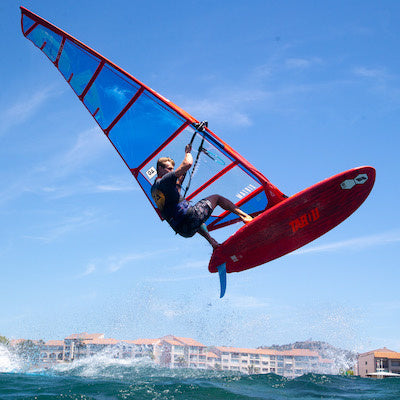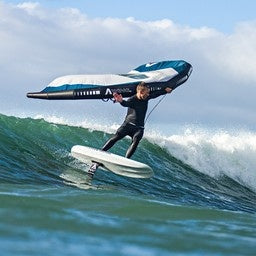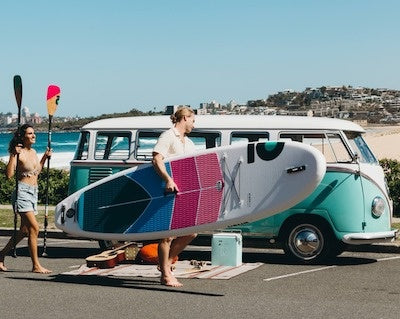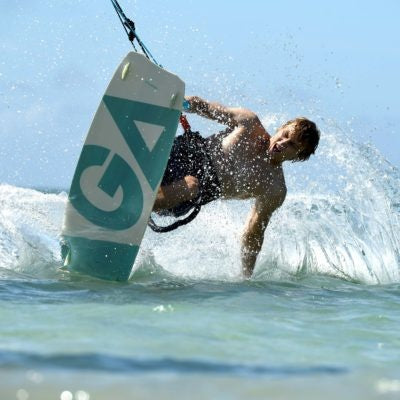Collection: Windsurfing Board Buyer's Guide
Buyers guide to Windsurfing Equipment
Buying the right windsurfing equipment is fundamental to enjoyment and progressing in the sport. There are two main areas of windsurfing equipment which are needed to get on the water and go windsurfing and depending on a persons windsurfing ability, elements of equipment will differ. These include:
- Board
- Rig - made up of a sail, mast, boom and mast extension
Windsurfing Disciplines:
There are different forms of windsurfing or ‘disciplines’, and depending on windsurfing level, chosen location and rider style, the board design and characteristics differ. The most popular disciplines include:
- Beginner: Stable platform with high volume, which is often fitted with a daggerboard, designed specifically for learning to windsurf
- Freeride: Early planing, ease of use and for a variety of conditions
- Freestyle: highly manoeuvrable, loose design, which is lively under foot and early planing, used for tricks and rotations
- Wave: short manoeuvrable board designed to be used in waves, generally with multiple fin options
- Slalom: Designed for straight-line speed and hard turns
- Foil: Short, wide boards designed to be fitted with a hydrofoil
The Board
When learning to windsurf, the board is larger and designed to provide stability, enabling quick progression. As skills develop, our board choice will vary.
Beginner and improver windsurfing boards may also be fitted with a ‘daggerboard’. A large, flat plate which pivots through the middle of the board and is usually fully retractable. The daggerboard when in the downwards position provides stability and resistance, stopping the board from sliding sideways, and assisting the rider to sail in angles closer to the wind (upwind).
At a beginner level it is more advisable to have windsurfing lessons rather than investing in a board. Progression is quick at this stage and most children and adults aren’t on beginners boards for long - often less than a week and they have the skills to move on!
Width
Wider boards provide stability, especially at beginner and improver levels. The downside, as competency increases, the rider naturally ventures out in varying conditions and choppier water states, which can make the board feel unstable and harder to control.
Rocker
The word ‘Rocker’ is used to describe how flat or curved the shape of a board is ‘nose to tail’, but generally rocker is more prominent in the nose. Rocker dictates ability to turn, as well as how well it copes with confused and choppy water states or waves.
For example, a wave board has increased rocker in the nose and sometimes tail, enabling the rider to perform tighter turns, whilst also preventing the nose submerging when wave sailing.
In contrast, boards designed for Freeride and Slalom are flatter in design, with less rocker. This shape encourages early planing and higher speeds, but impacts tightness in which they can turn.

Tail
A boards tail design can be quite complicated with multiple features assisting its end riding objective. Keeping it simple:
- Thin and sharp, for example a wave board: Increased water release, providing good carving characteristics, slower onto the plane
- Wider and curved, such as a freeride board: Early planing, grip the water, volume in the tail provides increased stability.
Hull shape
The underside shape of a board, also referred to as the ‘hull shape’, impacts how early a board planes, efficiency through water states and manoeuvrability.
There are three under-hull designs which are most common; Concave, double concave and V-shaped.
- Concave and double concave encourage early planing, as well as good top-end speed by reducing the wetted area in the water once up and planing.
When used on wider boards, boards with these undersides may feel less stable through chop and, depending on rail shape, may be more challenging to gybe.
- Vee shaped describes the side to side shape of the board underneath, with more Vee shape providing stability, and control for carving manoeuvres, but with a compromise in speed.
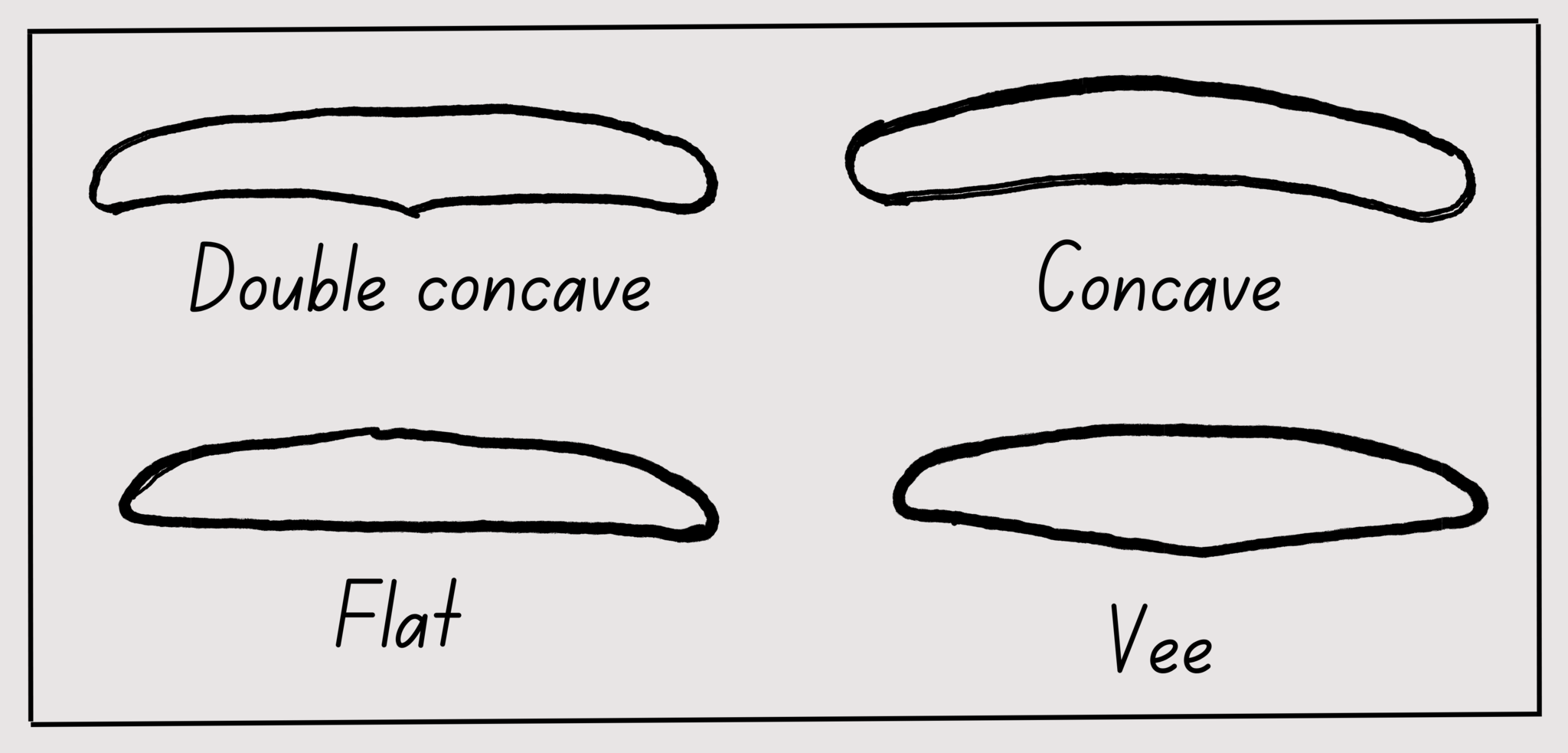
Rail Shape
The rails or ‘side’ aspect shape of the board are generally referred to as ‘hard or soft’.
‘Hard’ rails have more of an ‘edge’, cutting through and releasing the water, causing minimal friction. Resulting in better acceleration and speed.
‘Soft’ rails are more ‘curved’, gripping the water and providing more control for transitions and manoeuvres.
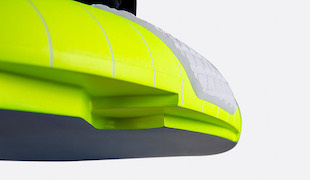
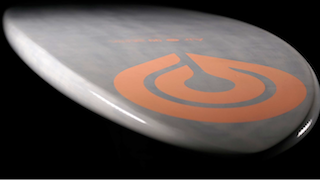
Volume
A boards volume dictates how much it will ‘float or sink’ underfoot, with the distribution differing dependant on performance and rider requirements.
Windsurfing boards are measured in litres, with ‘one litre supporting one kilogram of weight’.
When learning to windsurf, the board should be stable and buoyant, with plenty of extra volume in addition to a riders personal weight, as ability progresses a board with less volume is required and often desired. For example a rider wishing to sail in waves or stronger winds, will choose a smaller, even negative ‘reserve’ volume, whilst for light wind cruising, some reserve volume increases comfort and marginal planing ability.
Any additional volume above the riders personal weight will enable the board to ‘float’, this is referred to as ‘reserve volume’. In contrast, a board with volume lower that the sailors weight will sink.
A great way to find a board with a suitable volume is by using the guide below which considers the combined weight of the sailor and rig, providing a number in litres which can then be adapted to ability.
Firstly determine the volume required to support the sailor when standing on the board by calculating:
Sailors weight (kg) + 20kg (rig, wetsuit) = Floating volume in litres.
For example:
|
Sailor weight (kgs) |
|
80 kg |
|
|
20 kg |
|
|
|
100 kg |
|
|
Converted into litres |
100 litres |
In the example above, the sailor would need a board above 100litres to float, anything below this would start to sink
Next, add or subtract the ‘reserve’ number from the the guide below which roughly determines how much extra volume is needed to find a suitable board, considering ability, intended use and style:
|
|
Ability level |
Add/subtract |
|
Beginner |
New to the sport, learning the basics |
Double |
|
Improver |
Learning to use harness, not in the footstraps |
+60-80 (litres) |
|
Early Intermediate |
Learning to use the footsteps and get planing, still enabling uphauling |
+ 30-60 (litres) |
|
Intermediate |
In the footstraps/learning to waterstart |
+ 10-30 (litres) |
|
Advanced |
Most riders at this level will have determined the right board volume, and may vary boards depending on conditions |
|
An example using the guide above
Beginner:
Sailor weighing 80kg,
+ 20kg (rig)
= 100kg
100kg x ‘Doubled’ = 200 litres.
Therefore this sailor should look to learn on a windsurfing board around/above 200litres, providing 100litres of ‘float/reserve volume’ giving great stability for learning.

